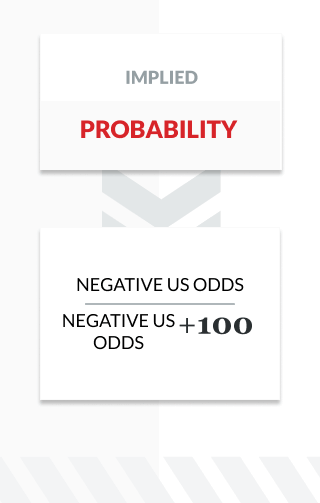Odds To Probability Formula
You might have noticed that we make statements like the trains may be late, it may take an hour, to reach home and so forth. This type of statements indicates the probability of an event, as its occurrence is not certain. It implies the extent to which an event is possible to happen.
Probability is divided into two types, objective and subjective probability. Subjective probability is based on attitude, belief, knowledge, judgment and experience of the person. In mathematics, we study objective probability.
Probability is not similar to odds, as it represents the probability that the event will happen, upon the probability that the event will not happen. Now, let’s take a look at the difference between odds and probability provided in the article below.
Content: Odds Vs Probability
Comparison Chart
| Basis for Comparison | Odds | Probability |
|---|---|---|
| Meaning | Odds refers to the chances in favor of the event to the chances against it. | Probability refers to the likelihood of occurrence of an event. |
| Expressed in | Ratio | Percent or decimal |
| Lies between | 0 to ∞ | 0 to 1 |
| Formula | Occurrence/Non-occurrence | Occurrence/Whole |
Definition of Odds

In mathematics, the term odds can be defined as the ratio of number of favourable events to the number of unfavourable events. While odds for an event indicates the probability that the event will occur, whereas odds against will reflect the likelihood of non-occurrence of the event. In finer terms, odds is described as the probability that a certain event will happen or not.
Convert the odds to their probability.3. Convert the probability of your preferred odds format. For example, “Decimal Odds” of 3.00 is a 33.3% probability, which can then be converted into traditional odds of 2/1. This article discusses this process of unequal conversion in.
Odds 5/2 (expressed as “5 to 2”), which means that for every 2 units you bet, you get 5 back as a win. So if you bet 200kr. On that horse, you would have received 500kr. Win plus your original bet of $ 200. Convert traditional odds to probability formula. Given here are the log odds and odds formulas to find the odds, log odds and expected proportion based on the values of any two. The expected proportion is the probability of success on each trial. The odds, also known as 'Odds for' reflect the likelihood that the event will take place, while the 'odds against' is the likelihood that the event. Odds can be expressed as a ratio of two numbers (so as 1/2 odds and 100/200 odds are the same), or as a number, by dividing the terms in the ratio (0.5 in the above example). Probability is expressed as a decimal number in the range 0,1. O = P 1 − p The above formula is used to calculate odds from the probability. P = O O + 1 On the other hand, the above formula is used in order to calculate probability from the odds.
Odds can range from zero to infinity, wherein if the odds is 0, the event is not likely to happen, but if it is ∞, then it is more likely to happen.
For example Suppose, there are 20 marbles in a bag, eight are red, six are blue, and six are yellow. If one marble is to be picked at random, then the odds of getting red marble is 8/12 or say 2:3
Definition of Probability

Probability is a mathematical concept, which is concerned with likelihood the occurrence of a particular event. It forms the basis for a theory for testing of hypothesis and theory of estimation. It can be expressed as the ratio of the number of events favourable to a specific event, to the total number of events.
Probability ranges from 0 and 1, both inclusive. So, when the probability of an event is 0, it denotes an impossible event, whereas when it is 1, it is an indicator of the certain or sure event. In short, the higher the probability of an event, the greater are the chances of the occurrence of the event.
For example: Suppose a dartboard is divided into 12 parts, for 12 zodiacs. Now, if a dart is targeted, the chances of occurrence of areas are 1/12, as the favourable event is 1, i.e. Aries and a total number of events are 12, that can be denoted as 0.08 or 8%.
Key Differences Between Odds and Probability
The differences between odds and probability are discussed in the points given below:
- The term ‘odds’ is used to describe that if there are any chances of the occurrence of an event or not. As against, probability determines, the likelihood of the happening of an event, i.e. how often the event will take place.
- While odds are expressed in the ratio, the probability is either written in percentage form or decimal.
- Odds usually ranges from zero to infinity, wherein zero defines impossibility of occurrence of an event, and infinity denotes the possibility of occurrence. Conversely, probability lies between zero to one. So, the closer the probability to zero, the more are the chances of its non-occurrence and the closer it is to one, the higher are the chances of its occurrence.
- Odds are the ratio of favourable events to the unfavourable event. In contrast, the probability can be calculated by dividing the favourable event by the total number of events.
Conclusion


Probability is a branch of mathematics, which includes odds. One can measure chance, with the help of odds or probability. While odds are a ratio of occurrence to non-occurrence, the probability is the ratio of occurrence to the whole.
Related Differences
You Might Also Like:
Definition
Odds: the ratio of the probability that an event will occur versus the probability that the event will not occur, or probability / (1-probability). For example, if you are normally on call 2 out of 7 days in a week, then the odds of you being on call on a certain day of the week is [(2/7)/(5/7)] = 0.40. Note that this differs from risk (or probability): the risk of being on call is equal to (# of call days )/ (total # of days in a week) = 2/7 = 0.285.
Odds ratio: a ratio of odds; in general they refer to the ratio of the odds of an event occurring in the exposed group versus the unexposed group. For example, lets say you want to compare the differences between PONV in women undergoing total abdominal hysterectomy receiving Drug X and those who do not, controlling for all other variables. You compare 100 different cases.
The odds of PONV having received Drug X is 20/80 or 0.25. The odds of PONV without Drug X is 40/60 or 0.67. Therefore, the odds ratio for PONV with Drug X vs. PONV without Drug X is 0.25/0.67 or 0.37. The probability of PONV having received Drug X is 20/100 or 0.20. The probability of PONV with no Drug X is 40/100 or 0.40. Therefore, the relative risk for PONV with Drug X vs. PONV without Drug X is 0.20/0.40 = 0.5.
Odds ratios are used instead of relative risk for case-control studies. To be able to calculate relative risk, we compare the risks of outcome in different groups. In case-control studies, we already know what the outcome is and we separate groups into those with the outcome vs. controls. Our objective in such studies is to try to identify risk factors that are more strongly associated with one group than the other; thus, risk and therefore relative risk cannot be calculated from these studies. We use odds ratios instead, which can give us a measure of how strongly the risk factor is associated with the outcome.
For example, if we suspect that Drug X is associated with less PONV, then we could take 100 patients with out PONV to 100 patients with PONV and see how many in each group received Drug X. Since we select the outcome in both groups, we cannot calculate the relative chance (risk) of less PONV in the Drug X group because we do not know the chance of no PONV in the general population (who are not Drug X users), and therefore we have no comparison group. However, we can compare the odds of the use of Drug X in those who had no PONV vs. those who had PONV by calculating the odds ratio. So for example:
You can say that the odds of use of Drug X were 2.7 times greater in non PONV patients vs. PONV patients in this study. This implies an association between use of Drug X and preventing PONV. However, many other things could have contributed to this apparent association: chance alone could have accounted for this difference (helpful to know the 95% CI for the OR); the sample selected for both groups could have been skewed to favor Drug X use in the non-PONV group.
Summary
Odds = Probability / (1-probability).
Odds ratio (OR) = ratio of odds of event occurring in exposed vs. unexposed group.
How To Go From Odds To Probability
Odds ratio are used to estimate how strongly a variable is associated with the outcome of interest; in prospective trials, it is simply a different way of expressing this association than relative risk.
In case-control studies, we separate groups by their outcomes and retrospectively try to identify variables that appear to be more associated with one outcome than another. Therefore, we cannot deduce a calculable risk because the outcome has already been predetermined. We therefore use odds ratios instead to estimate the strength of association of the variable with the outcome of interest.
In a prospective study, either a Randomized Clinical Trial or a Cohort study, use Relative Risk.